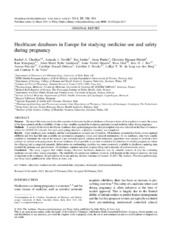| dc.contributor.author | Charlton, Rachel A. | en_US |
| dc.contributor.author | Neville, Amanda J. | en_US |
| dc.contributor.author | Jordan, Sue | en_US |
| dc.contributor.author | Pierini, Anna | en_US |
| dc.contributor.author | Damase-Michel, Christine | en_US |
| dc.contributor.author | Klungsøyr, Kari | en_US |
| dc.contributor.author | Andersen, Anne-Marie Nybo | en_US |
| dc.contributor.author | Hansen, Anne Vinkel | en_US |
| dc.contributor.author | Gini, Rosa | en_US |
| dc.contributor.author | Bos, Jens H.J. | en_US |
| dc.contributor.author | Puccini, Aurora | en_US |
| dc.contributor.author | Hurault-Delarue, Caroline | en_US |
| dc.contributor.author | Brooks, Caroline J. | en_US |
| dc.contributor.author | De Jong-van den Berg, Lolkje T.V. | en_US |
| dc.contributor.author | de Vries, Corinne S. | en_US |
| dc.date.accessioned | 2015-03-27T10:58:44Z | |
| dc.date.available | 2015-03-27T10:58:44Z | |
| dc.date.issued | 2014-06 | eng |
| dc.identifier.issn | 1053-8569 | |
| dc.identifier.uri | https://hdl.handle.net/1956/9685 | |
| dc.description.abstract | Purpose The aim of this study was to describe a number of electronic healthcare databases in Europe in terms of the population covered, the source of the data captured and the availability of data on key variables required for evaluating medicine use and medicine safety during pregnancy. Methods A sample of electronic healthcare databases that captured pregnancies and prescription data was selected on the basis of contacts within the EUROCAT network. For each participating database, a database inventory was completed. Results Eight databases were included, and the total population covered was 25 million. All databases recorded live births, seven captured stillbirths and five had full data available on spontaneous pregnancy losses and induced terminations. In six databases, data were usually available to determine the date of the woman's last menstrual period, whereas in the remainder, algorithms were needed to establish a best estimate for at least some pregnancies. In seven databases, it was possible to use data recorded in the databases to identify pregnancies where the offspring had a congenital anomaly. Information on confounding variables was more commonly available in databases capturing data recorded by primary-care practitioners. All databases captured maternal co-prescribing and a measure of socioeconomic status. Conclusion This study suggests that within Europe, electronic healthcare databases may be valuable sources of data for evaluating medicine use and safety during pregnancy. The suitability of a particular database, however, will depend on the research question, the type of medicine to be evaluated, the prevalence of its use and any adverse outcomes of interest. © 2014 The Authors. Pharmacoepidemiology and Drug Safety published by John Wiley & Sons, Ltd. | en_US |
| dc.language.iso | eng | eng |
| dc.publisher | Wiley | eng |
| dc.rights | Attribution-NonCommercial-NoDerivs CC BY-NC-ND | eng |
| dc.rights.uri | http://creativecommons.org/licenses/by-nc-nd/3.0/ | eng |
| dc.subject | electronic medical records | eng |
| dc.subject | automated data | eng |
| dc.subject | Pregnancy | eng |
| dc.subject | teratogens | eng |
| dc.subject | Pharmacoepidemiology | eng |
| dc.title | Healthcare databases in Europe for studying medicine use and safety during pregnancy | en_US |
| dc.type | Peer reviewed | |
| dc.type | Journal article | |
| dc.date.updated | 2015-03-04T11:45:00Z | en_US |
| dc.description.version | publishedVersion | en_US |
| dc.rights.holder | Copyright 2014 The Authors | |
| dc.identifier.doi | https://doi.org/10.1002/pds.3613 | |
| dc.identifier.cristin | 1160554 | |
| dc.source.journal | Pharmacoepidemiology and Drug Safety | |
| dc.source.40 | 23 | |
| dc.source.14 | 6 | |
| dc.source.pagenumber | 586-594 | |
| dc.subject.nsi | VDP::Medical sciences: 700::Health sciences: 800::Health service and health administration research: 806 | eng |
| dc.subject.nsi | VDP::Medisinske fag: 700::Helsefag: 800::Helsetjeneste- og helseadministrasjonsforskning: 806 | nob |

